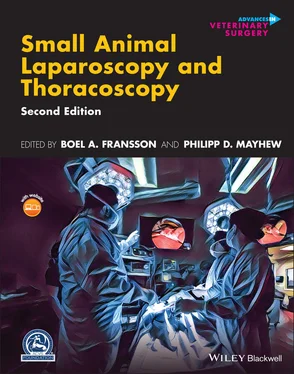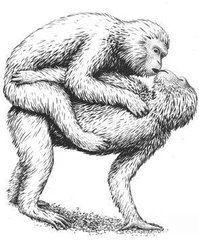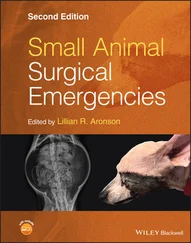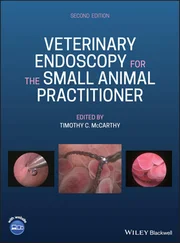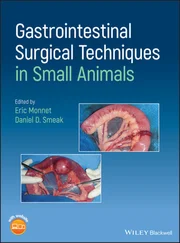1 Cover
2 Series page To my husband Claude for inspiration and support in every aspect of life. To my daughters Selma and Ella for providing endless joy, life balance, and perspective. To the surgical residents who make me grow as a mentor and a surgeon. And to my parents, Sivert and Anita, whose unconditional love and support formed my foundation. BAF To my parents Alan and Hildegard for their unwavering support, kindness, and generosity. To my wife Kelli and my children Reece, Aidan, and Brynn for making life so rich and rewarding and full of joy and laughter. PM
3 Title Page Small Animal Laparoscopy and Thoracoscopy Second Edition Edited by Boel A. Fransson, DVM, PhD, Dipl. ACVS Washington State University Pullman, WA, USA Philipp D. Mayhew, BVM&S, DACVS University of California‐Davis Davis, CA, USA
4 Copyright Page
5 Contributors
6 Foreword
7 Foreword
8 Preface
9 Acknowledgment
10 About the Companion Website
11 History of Small Animal Laparoscopy and Thoracoscopy Endoscopy in the Nineteenth Century 1930s: The Glory Days Out in the Cold: 1940s to mid‐1960s Controversy Galore: 1970s to 1990s Small Animal MIS Acknowledgments References
12 Section I: Laparoscopic Skills 1 Surgeons' Skills Training Adding Minimally Invasive Surgery to a Surgeon's Repertoire Basic Laparoscopic Skills Simulation Training Models Self‐Directed Training Miscellaneous Training; Video and Serious Games References 2 Minimally Invasive Suturing Techniques Introduction to Laparoscopic Suturing Needle Holders for Laparoscopic Suturing Suture Materials for Minimally Invasive Suturing Intracorporeal Hand Suturing Technique Extracorporeal Suturing Automated Suturing Devices References
13 Section II: Equipment 3 Imaging Equipment and Operating Room Set‐Up Imaging Equipment Imaging Chain Telescopes Light Sources Light Cables Endoscopic Video Cameras Capture and Storage of Images and Video Video Carts and Ceiling Booms Integrated and Intelligent Operating Rooms Operating Room Setup Preparation for Open Surgery Planning Coordination and Efficiency References 4 Surgical Instrumentation 4.1 Surgical Instrumentation Instrument Design Forceps Scissors Tissue Retractors Needle Holders and Suturing Devices Laparoscopy Packs 4.2 Trocars and Cannulas The Trocar, Cannula, and Sheath Cannula Seal Obturator Trocar–Cannula Placement Veress Needle Technique Direct Insertion Technique Hasson Technique Types of Trocar Assemblies Disposable Trocar Assemblies Nondisposable Trocar Assemblies Trocar Assembly‐Related Complications Vascular Injury Visceral Injury Port Closure Devices References 4.3 Miscellaneous Surgical Instrumentation Specimen Retrieval Bags Suction and Irrigation Devices Wound Protector and Retractor Devices Morcellators References 5 Energy Devices and Stapling Equipment Electrosurgical Theory Waveforms Monopolar Electrosurgery Bipolar Electrosurgery Tissue Fusion Device Ultrasonic Dissector Microwave Ablation Clip and Staple Applicators References 6 Single Incision Laparoscopic Surgical Platforms Development of a New Platform Adoption into Veterinary Laparoscopy Access Methods for Single‐Port Surgery Single‐Port Access Commercially Available Single‐Port Devices Principles of Single‐Port Surgery Access in Single‐Port Surgery TriPort System (Olympus) Innovative Adaptations of Existing Equipment Conclusion References
14 Section III: Fundamental Techniques in Laparoscopy 7 Anesthesia Management of Dogs and Cats for Laparoscopy Introduction Anesthesia Considerations Related to Disease Anesthesia Considerations Related to Surgery Pathophysiology of Pneumoperitoneum Complications Associated with Pneumoperitoneum Anesthesia Management Summary References 8 Laparoscopic Access and the Working Space Necessary Considerations Before Laparoscopic Access Closed‐Entry Techniques (Blind) Open‐Entry Techniques Ternamian Visual Entry Evidence for Entry Technique Safety and of Efficacy Single‐Access Surgery Access to the Retroperitoneal Space The Laparoscopic Working Space The Pneumoperitoneum Conclusion References 9 Laparoscopic Contraindications, Complications, and Conversion Contraindications Complications Conversion References
15 Section IV: Laparoscopic Surgical Procedures 10 Diagnostic Laparoscopy of the Gastrointestinal Tract Preoperative Considerations Patient Preparation Surgical Techniques Complications References 11 Laparoscopic‐Assisted Feeding Tube Placement, Gastrotomy, Enterotomy, and Intestinal Resection and Anastomosis Laparoscopic‐Assisted Feeding Tube Placement Surgical Techniques Complications Postoperative Care Laparoscopic‐Assisted Gastrotomy, Enterotomy, Intestinal Resection and Anastomosis Patient Preparation Surgical Techniques Postoperative Care References 12 Laparoscopic and Laparoscopic‐Assisted Gastropexy Techniques Preoperative Considerations Patient Preparation Surgical Techniques Complications and Prognosis Postoperative Care References 13 Laparoscopic Treatment of Hiatal Hernias and Associated Gastroesophageal Reflux Clinical Presentation Diagnostic Imaging Functional Assessment of the LES and Antireflux Barrier Medical Management of GER and SHH Surgical Management References 14 Laparoscopic Splenectomy Introduction Preoperative Considerations Patient Preparation Surgical Techniques Complications and Prognosis Postoperative Care References 15 Laparoscopic Liver Biopsy, Resection, Ablation and Cholecystocentesis Preoperative Considerations Patient Preparation Surgical Technique Complications Postoperative Care References 16 Laparoscopic Cholecystectomy Preoperative Considerations Patient Preparation Surgical Technique Procedure Bile Duct Flushing and Intraoperative Cholangiography (IOC) Laparoscopic Common Bile Duct Exploration and Treatment of Obstruction Complications of Laparoscopic Cholecystectomy and Their Management Management for Complications and Severe Cases Postoperative Care Acknowledgment References 17 Laparoscopic Adrenalectomy Preoperative Considerations Patient Preparation Surgical Technique Retroperitoneal Surgical Technique Complications and Prognosis Postoperative Care References 18 Laparoscopic Surgery of the Pancreas Preoperative Considerations Patient Preparation Surgical Technique Complications and Prognosis Postoperative Care References 19 Laparoscopic Renal Biopsy Indications for Renal Biopsy Preoperative Considerations Patient Preparation Instrument Placement Biopsy Needle Technique Cup Biopsy Technique Sample Handling and Submission Complications Associated with Renal Biopsy Postoperative Care References 20 Laparoscopic Ureteronephrectomy Preoperative Considerations Patient Preparation Surgical Technique Complications and Prognosis Postoperative Care References 21 Transurethral Cystoscopy and Laparoscopic‐Assisted Cystotomy for Urolith Removal and Mass Resection Preoperative Considerations Patient Preparation Surgical Technique(s) Complications and Prognosis Postoperative Care Bladder Tumor Biopsy and Polyp Resection References 22 Laparoscopic Ovariectomy, Ovariohysterectomy, and Hysterectomy Preoperative Considerations Patient Preparation Surgical Technique Complications Postoperative Care Hormone Sparing Spay; Hysterectomy Patient Selection Operating Room Set Up and Portal Placement Relevant Anatomy Considerations Surgical Procedure Laparoscopy‐assisted Hysterectomy Surgical Technique Postoperative Care Outcome References 23 Laparoscopic Castration and Sterilization Techniques of the Male Dog Background to Alternative Castration and Sterilization Techniques Laparoscopic Castration by Devascularization Challenges Specific to the Technique Postoperative Care Complications and Prognosis Laparoscopic Canine Vasectomy Surgical Technique Recovery Complications Outcome Cryptorchidectomy Complications and Prognosis Postoperative Care References 24 The Role of Laparoscopy in Cancer Staging Diagnostic Laparoscopy and Biopsy Lymphatic Staging Preoperative Considerations Patient Preparation Surgical Technique Complications and Challenges Postoperative Care References 25 Diaphragmatic and Inguinal Herniorrhaphy Anatomy and Physiology of the Diaphragm Laparoscopic Peritoneopericardial Diaphragmatic Herniorrhaphy (PPDH) Surgical Technique Surgical Techniques for Inguinal and Abdominal Hernias References 26 Natural Orifice Translumenal Endoscopic Surgery: NOTES Natural Orifice Translumenal Endoscopic Surgery (NOTES) History of NOTES Advantages and Disadvantages of NOTES Surgical Techniques via Transgastric NOTES Transvaginal NOTES Using Flexible and Rigid Endoscope Preoperative Considerations Surgical Techniques via Transvaginal H‐NOTES Abdominal and Transvaginal Access H‐NOTES Ovariectomy H‐NOTES Ovariohysterectomy Surgical Techniques by Transvaginal T‐NOTES T‐NOTES Ovariectomy T‐NOTES Ovariohysterectomy Complications and Considerations for Future Application References
Читать дальше
